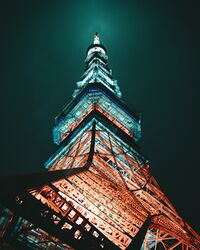Maimedo: Difference between revisions
No edit summary |
No edit summary |
||
| Line 13: | Line 13: | ||
| imagesize = | | imagesize = | ||
| image_alt = | | image_alt = | ||
| image_caption = '''Clockwise from top:'''{{hlist|[[Esonice|--]]|[[ | | image_caption = '''Clockwise from top:'''{{hlist|[[Esonice|--]]|[[Maimedo#Cityscape|Seian-chaseki]] in [[Esonice#Cityscape|Seian Park]]|[[Esonice|-- Castle]] entrance|[[Esonice|Maimedo Tower]]|[[Esonice|--]] and [[Esonice|--]] in [[Esonice|Maimedo Harbour]]}} | ||
| image_flag = Flag of Maimedo.png | | image_flag = Flag of Maimedo.png | ||
| flag_alt = | | flag_alt = | ||
| Line 133: | Line 133: | ||
}} | }} | ||
Maimedo is the capital city of [[Esonice| | Maimedo (maɪmɛdəʊ; Esonian: 橙水, maimɛdɔ), also semi-officially known as Maikyo (maɪkiəʊ; Esonian: 橙京, maikʲoː), officially the Capital City of Maimedo is the national capital and largest city in Esonice with an estimated population of 992,351. The metropolitan area which includes an estimated population of 3,129,121 brings the greater city’s metropolitan population to 4,121,472 inhabitants. For nearly a millennia since the 12th century, Maimedo was and continues to be Esonice’s beating political and cultural heart. It’s a centre of traditional and modern Esonian fashion, cuisine, literature and art. It’s also an important centre of finance and commerce in the nation. Because of its many orange ladenned terracotta and clay tiled roofs including copper coloured limestone and stone buildings, Maimedo became known in Esonian poetic literature as the “Orange City”, hence its nickname. | ||
Maimedo is tied with [[Marusonya|Marusonya]] on the {{wp|standard of living|highest standard of living}} in [[Esonice|Esonice]], however it's beaten by Marusonya in {{wp|quality of life|quality of life}}, coming in second though still closely behind. | |||
==Etymology== | ==Etymology== | ||
==History== | ==History== | ||
===Origins=== | |||
===12th and 19th centuries=== | |||
===Decay and destruction=== | |||
===Contemporary period=== | |||
==Geography== | ==Geography== | ||
{{multiple image | |||
| align = right | |||
| total_width = 350 | |||
| image_style = border:none; | |||
| image1 = Prunus campanulata (46807258921).jpg | |||
| alt1 = | |||
| caption1 = {{wp|Prunus campanulata|''Prunus campanulata''}}, known as the bellflower cherry is Maimedo's city tree and has been used to breed several other types of cherry blossoms in Esonice. | |||
| image2 = Wisteria brachybotrys.jpg | |||
| alt2 = | |||
| caption2 = {{wp|Wisteria brachybotrys|''Wisteria brachybotrys''}}, known as the silky wisteria is a very popular plant in Maimedo can be seen climbing various buildings across the city, it's why it was made the city's flower. | |||
}} | |||
==Government== | ==Government== | ||
| Line 146: | Line 168: | ||
==Cityscape== | ==Cityscape== | ||
===Urbanism and architecture=== | |||
[[File:Akasaka Palace 5.jpg|200px|thumb|The Seian Palace State Guest House located on the north eastern end of Seian park is an example of the short Neoclassical period of Maimedo introduced by Iverican architects in the 1940s and early 1950s during Maimedo's reconstruction]] | |||
[[File:Maimedo tower at night.jpeg|200px|thumb|left|Maimedo Tower constructed in the 1970s, originally widely criticised as a hideosity in Maimedo's skies has since become an accepted icon of the city]] | |||
===Green spaces=== | |||
[[File:Edo Castle (江戸城) East Garden 2 by Don Ramey Logan.jpg|200px|thumb|Seian Park, Silent Gardens Park is the largest park in Esonice.]] | |||
==Transport== | ==Transport== | ||
| Line 158: | Line 189: | ||
==Culture== | ==Culture== | ||
===Architecture=== | |||
===Liturature=== | |||
===Art and galleries=== | |||
===Local festivals=== | ===Local festivals=== | ||
=== | ===Cuisine=== | ||
===Sport=== | |||
==Demographics== | |||
=== | ===Religion=== | ||
Maimedo has 21 Buddhist temples and 127 Shinshi shrines | |||
==International relations== | ==International relations== | ||
Revision as of 16:00, 30 March 2023
This article is incomplete because it is pending further input from participants, or it is a work-in-progress by one author. Please comment on this article's talk page to share your input, comments and questions. Note: To contribute to this article, you may need to seek help from the author(s) of this page. |
Maimedo
橙水 | |
|---|---|
| City of Maimedo | |
 Clockwise from top:
| |
| Nickname(s): Maikyo, Maishi, Orange City | |
| Country | |
| Province | Kinkai-koku |
| County | Maimedo-gun |
| Municipal | Maimedo-wu |
| Local | Wards of Maimedo |
| Government | |
| • Body | City Government of Maimedo |
| Area | |
| • Capital | 736.4 km2 km2 (284.32 sq mi) |
| Population (2022) | |
| • Capital | 992,351 |
| • Rank | 1st in Esonice |
| • Density | 1,300/km2 (3,500/sq mi) |
| • Metro | 3,129,121 |
| • Total | 4,121,472 |
| Demonym | Maimedoite |
| Time zone | UTC-8 |
| Post Code | ES-132 |
| Flower | Silky wisteria |
| Food | Sushi donut |
| Tree | Bellflower cherry |
Maimedo (maɪmɛdəʊ; Esonian: 橙水, maimɛdɔ), also semi-officially known as Maikyo (maɪkiəʊ; Esonian: 橙京, maikʲoː), officially the Capital City of Maimedo is the national capital and largest city in Esonice with an estimated population of 992,351. The metropolitan area which includes an estimated population of 3,129,121 brings the greater city’s metropolitan population to 4,121,472 inhabitants. For nearly a millennia since the 12th century, Maimedo was and continues to be Esonice’s beating political and cultural heart. It’s a centre of traditional and modern Esonian fashion, cuisine, literature and art. It’s also an important centre of finance and commerce in the nation. Because of its many orange ladenned terracotta and clay tiled roofs including copper coloured limestone and stone buildings, Maimedo became known in Esonian poetic literature as the “Orange City”, hence its nickname.
Maimedo is tied with Marusonya on the highest standard of living in Esonice, however it's beaten by Marusonya in quality of life, coming in second though still closely behind.
Etymology
History
Origins
12th and 19th centuries
Decay and destruction
Contemporary period
Geography
Government
Wards
Cityscape
Urbanism and architecture
Green spaces
Transport
Trams
Economy
Tourism
Education
Culture
Architecture
Liturature
Art and galleries
Local festivals
Cuisine
Sport
Demographics
Religion
Maimedo has 21 Buddhist temples and 127 Shinshi shrines






